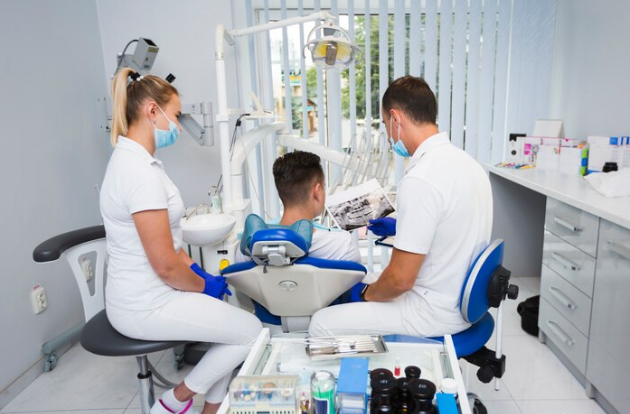
Dental Restorations are not new in the field of dentistry and have been in use for many years. Today, advances in technology have enabled dentists to provide more advanced treatments that can maintain a person’s natural teeth and preserve their dental health.
Dental restorations can include fillings, crowns, bridges, veneers, implants, root canal treatment and even dentures. Taking good care of your restorations can make them last a while – sometimes they can even be permanent!
Dental restoration experts work with patients to ensure they get the absolute best outcome. They make sure all their customers are satisfied with the results. Before beginning any type of restoration procedure, the dentist will first assess the patient’s individual needs and consider existing conditions or allergies. The dentist will then explain the different options and treatments available and help patients make an informed decision about their dental health.
Once a restoration procedure has been chosen, the dentist will carefully plan out how it should be done to ensure it’s effective and long lasting. ensure that it will be effective and long lasting. This includes choosing the right materials, making sure everything is properly aligned, and making sure that all existing teeth are correctly prepared before placing the restoration.
After this is done the dentist may use digital imaging or other modern technologies to take precise measurements of the patient’s bite so that they can create a perfect fit every time.
Once everything is set up, the dentist will usually begin by cleaning and preparing the area where they are going to place the restoration. They may also need to reshape any existing teeth to prepare for new restoration. After this, they can then carefully and precisely place and bond the restoration in place.
After you’re done with your dental treatment, it’s crucial to take care of your teeth so that it lasts for a long time. Proper oral hygiene is essential! This includes brushing regularly, flossing daily and visiting the dentist for regular check-ups. With the right care, a dental restoration can provide years of comfortable and healthy smiles.
Understanding the Differences Between Crowns and Bridges
Crowns and bridges are an ideal solution to fill in gaps that have been left behind due to missing teeth. They essentially help restore your smile and get it back to looking its best! A crown completely covers your tooth, while a bridge is bonded across a gap left by two healthy teeth or implants that were previously prepared to hold the bridge in place.
Not sure which one to go for – crowns or bridges? Both are perfect for bringing your smile back and making you feel more confident about it. But, there are some big differences between the two you should know before choosing one.
Crowns are made from a wide range of materials, including porcelain, metal alloys, zirconia, gold, or resin composite, among others. Depending on the specific requirements of each particular patient, each material has a set of advantages and disadvantages that are entirely unique.
Most often, crowns are used to cover a tooth that has been injured and has become weak as a result of decay, a fracture, or treatment with a root canal. The remaining tooth structure will be safeguarded by the crown, which will also assist in restoring the tooth to its usual form and appearance.
When there is a gap created by the absence of numerous teeth in a row, a bridge can be utilized to fill the space. A bridge can be used to replace missing teeth. It’s made up of crowns that are cemented on either side of the gap, so it looks like your natural teeth.
Rather than depending solely on dental crowns, bridges can also be supported by implants that are inserted in the jawbone. This provides a better degree of stability than using dental crowns alone. Bridges, in contrast to crowns, cannot be extracted and, as a result of wear and tear, need to be replaced every eight to ten years.
You will be more equipped to make an educated selection about what will serve your oral health requirements if you take into account both of the available possibilities. Your dentist will be able to offer you additional information and guide you in making a decision that is appropriate for the circumstances of your particular case.
It is essential to keep in mind that dental crowns and bridges offer the same benefits in terms of improving oral health and restoring a person’s confidence in their smile. If you take the necessary precautions, they can last for many years. If you are contemplating either of these choices, you should schedule an appointment with your dentist as soon as possible.
It is essential to have good oral health in order to have a beautiful and healthy smile, so be sure to brush your teeth, use dental floss, and see your dentist on a consistent basis. You can have a beautiful smile that is also healthy for many years to come if you take proper care of your teeth.
Frequently Asked Questions About Crowns and Bridges
Q: What is the difference between a crown and a bridge?
A: A crown completely envelops a tooth, while a bridge is cemented over the gap created by two healthy teeth or implants.
Q: How long do dental crowns and bridges last?
A: Dental crowns can last up to 15 years with proper care, while bridges can last up to 8-10 years.
Q: What are the benefits of getting a crown or bridge?
A: Crowns and bridges help improve oral health and restore confidence in your smile. They can also help prevent further tooth decay or damage. Additionally, they provide years of comfortable and healthy smiles.
Q: What is the process for getting a crown or bridge?
A: The process for getting a crown or bridge involves preparing the teeth or implants that will act as anchors, taking impressions of your mouth, ordering the device from a lab, and then fitting it over the prepared area during your next appointment. Your dentist will be able to provide you with more information about the specific requirements for each type of crown or bridge.
Q: Will my dental insurance cover crowns and bridges?
A: Many insurance plans will typically cover some portion of the cost, depending on your plan and the type of device you are having placed in your mouth. Be sure to check with your provider to determine what is covered by your plan.
Q: Are there any risks associated with getting a crown or bridge?
A: While the risk of complications is low, there may be some discomfort during and after the procedure, as well as some swelling or bruising around the area. Your dentist should provide you with additional information about potential risks before beginning treatment.
Get Dental Restorations From Us!
At Gentle Touch Family Dentistry, we provide both crowns and bridges to help you achieve your perfect smile. Our team is dedicated to making sure that each patient receives the highest quality treatment with the utmost care.
Contact us today if you are in need of a dental restoration, and let us help you get back on the road to having a beautiful, healthy smile!



